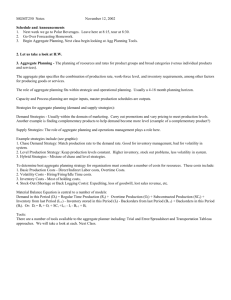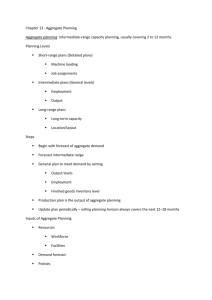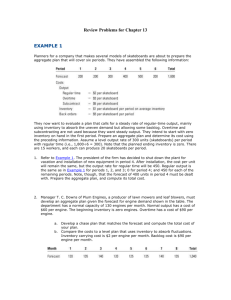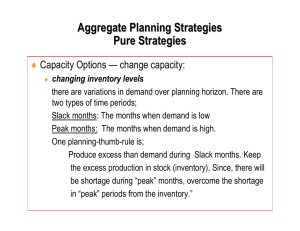AGGREGATE PLANNING
advertisement
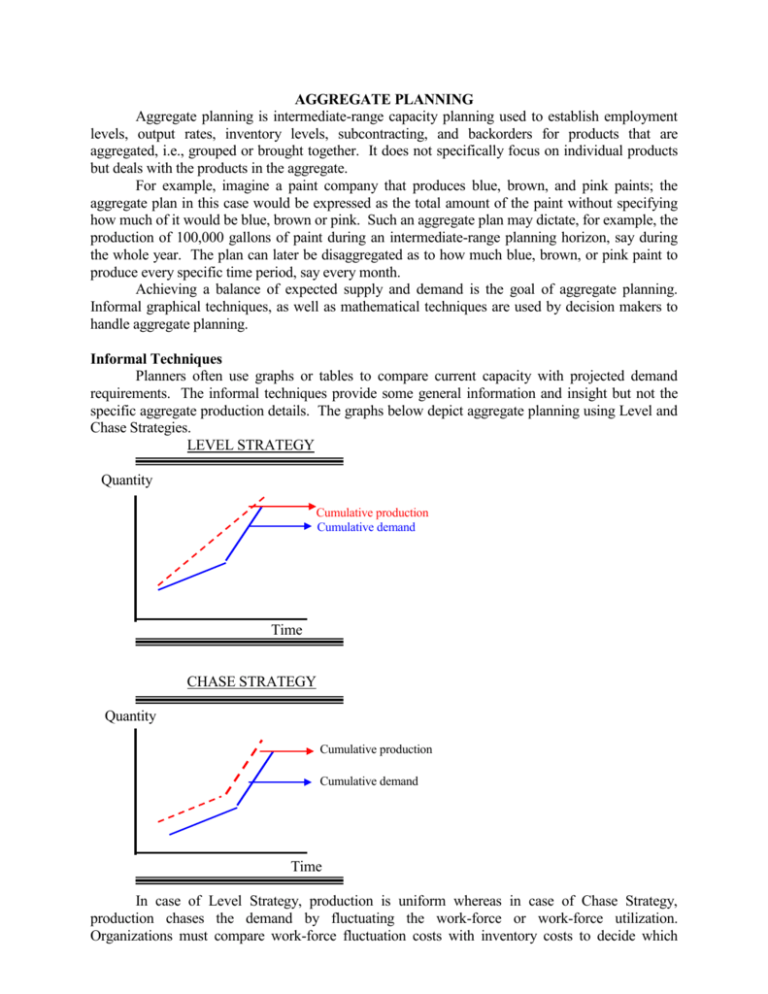
AGGREGATE PLANNING Aggregate planning is intermediate-range capacity planning used to establish employment levels, output rates, inventory levels, subcontracting, and backorders for products that are aggregated, i.e., grouped or brought together. It does not specifically focus on individual products but deals with the products in the aggregate. For example, imagine a paint company that produces blue, brown, and pink paints; the aggregate plan in this case would be expressed as the total amount of the paint without specifying how much of it would be blue, brown or pink. Such an aggregate plan may dictate, for example, the production of 100,000 gallons of paint during an intermediate-range planning horizon, say during the whole year. The plan can later be disaggregated as to how much blue, brown, or pink paint to produce every specific time period, say every month. Achieving a balance of expected supply and demand is the goal of aggregate planning. Informal graphical techniques, as well as mathematical techniques are used by decision makers to handle aggregate planning. Informal Techniques Planners often use graphs or tables to compare current capacity with projected demand requirements. The informal techniques provide some general information and insight but not the specific aggregate production details. The graphs below depict aggregate planning using Level and Chase Strategies. LEVEL STRATEGY Quantity Cumulative production Cumulative demand Time CHASE STRATEGY Quantity Cumulative production Cumulative demand Time In case of Level Strategy, production is uniform whereas in case of Chase Strategy, production chases the demand by fluctuating the work-force or work-force utilization. Organizations must compare work-force fluctuation costs with inventory costs to decide which strategy to use. Level Strategy is used when inventory costs are low as compared to the costs of fluctuating the work force and when efficient production is the primary goal. When inventory costs are high as compared to work force fluctuation costs, Chase Strategy is used, although it is less efficient for production. Aggregate Planning Strategies Apart form the production strategies such as Level and Chase Strategies, we also have planning strategies. There are three major strategies associated with aggregate planning: 1) product variations due to hiring, firing, overtime, or undertime, 2) permitting inventory levels to vary, and 3) subcontracting An example depicting these strategies is presented below along with some sample computations of the costs associated with these strategies: Level production is 300. Backorders are permitted. Initial Inventory is 70 units. 200 units are to be subcontracted for Period 6. Costs are as follows: Product Variations Inventory Subcontracting Shortage $20 /unit $3 /unit/period $25 /unit $7 /unit/period PRODUCTION PERIOD DEMAND REGULAR OVER INVENTORY UNDER BEG. END. AVG. SUBCONTRACT SHORTAGE 1 350 200 - 100 70 0 35 - 80 2 300 250 - 50 0 0 0 - 130 3 250 250 - 50 0 0 0 - 130 4 250 400 100 - 0 20 10 - 0 5 350 150 - 150 20 0 10 - 180 6 300 350 50 - 0 70 35 200 0 90 200 520 500 Costs For The Above Plan: Product Variations . . . . . . . 500 x $20 = $10,000 Inventory. . . . . . . . . . . …… 90 x $ 3 = $ 270 Subcontracting . . . . . . . . . . 200 x $25 = $ 5,000 Shortage . . . . . . . . . . . . ……520 x $ 7 = $ 3,640 Total . . . . . . . . . . ………….. $18,910 Rough-cut Capacity Planning Aggregate planning is based on a general production plan that deals with how much capacity will be available and how it will be allocated. A rough-cut capacity plan can be developed to evaluate the work load that a production plan imposes on work centers. Although a trial production plan is often used for rough-cut capacity planning, a trial master production schedule can be used too. The example below shows the application of rough-cut capacity planning based on a trial master schedule. MASTER PRODUCTION SCHEDULE MONTH PRODUCT 1 2 3 4 5 6 A 180 240 300 420 350 260 B 210 220 240 230 220 200 C 500 480 450 440 420 400 D 310 330 380 410 480 500 Below is a bill of labor which lists the hours required in each department to make one unit of product. PRODUCT DEPARMENT A B C D 11 0.4 0.2 0.7 0.5 22 0.1 0.6 0.4 0.9 33 1.1 0.3 0.7 0.6 44 0.3 0.8 0.2 0.5 55 0.5 0.0 0.4 0.6 Develop capacity requirements for the following combinations: MONTH 2 4 6 3 The solution is outlined below: DEPARTMENT 33 11 55 22 a. 240(1.1) + 220(0.3) + 480(0.7) + 330(0.6) = 864 hours b. 420(0.4) + 230(0.2) + 440(0.7) + 410(0.5) = 727 hours c. 260(0.5) + 200(0.0) + 400(0.4) + 500(0.6) = 590 hours d. 300(0.1) + 240(0.6) + 450(0.4) + 380(0.9) = 696 hours For example, we must have at least 864 hours available in Department 33 for Month 2 to meet capacity requirements. Suppose that we only have 640 man hours available in Department 33 in Month 2. Then, we can use aggregate planning strategies such as hiring, overtime, etc. to bring the capacity up to the required amount of 864 man or machine hours in order to comply with master production schedule. Note that this 864 hours is greater than the actual number of hours in a month(24 hours /day x 30 days / month = 720 hours / month). We may encounter this situation often because we are talking about the man or machine hours. For example, in case of a one 8-hour shift, 20 working days per month, and 10 workers, the man hours = 8 x 20 x 10 = 1,600. Work Force Size Planning In aggregate planning the major objective is to determine feasible and possibly optimal production quantities and the corresponding capacity (work force size) to accommodate such production requirements. An example of determining the appropriate work force size follows. The table below gives forecasted demand in four quarterly (3-month) periods: Quarter 1 2 3 4 1 year Forecast Demand (standard units of work) 6,000 4,500 4,200 5,500 20,200 a. Assume employees contribute 180 regular working hours each month, and each unit requires 2 hours to produce. How many employees will be needed during Quarter 1 and Quarter 2? b. What will be the average labor cost for each unit if the company pays employees $10/hour and maintains for the entire year a sufficient staff to meet the peak demand? c. What percentage above the standard-hour cost is the company's average labor cost per unit in this year due to excess staffing for all but the peak quarterly period? The solution is as follows: a. Quarter 1: 6000 x 2 = 12,000 hours ---> 23 employees Quarter 2: 4,500 x 2 = 9,000 ---> 17 employees b. 180 hours/employ.-month x 12 months x 23 employ. x $10/hour = 496,800 20,200 total units 20,200 = $24.59/unit c. 2 hours x $10/hour = $20/unit (standard cost) $24.59 -$20 = 0.23 or 23% higher $20 Other Mathematical Techniques The mathematical techniques used for aggregate planning vary from computer search models to heuristic and mathematical programming models. Six techniques are discussed below. 1. Linear Programming -- LP models can be used to minimize the sum of costs related to aggregate planning such as regular labor time, overtime, subcontracting, inventory, and backorder costs. The solution generated by LP models are optimal under the assumptions of linear programming. A linear programming application is shown below: Suppose that the costs associated with various capacity options are as shown in the table below: CAPACITY REGULAR OVERTIME SUBCONTRACT DEMEND INVENTORY HOLDING COST PERIOD 1 200 80 100 340 PERIOD 2 180 60 100 300 COST $20 /unit $25 /unit $30 /unit $3 /unit/period Backorders are not permitted in this case. Then, the linear programming formulation could be obtained as follows: PERIOD 2 PERIOD 1 PERIOD 1 PERIOD 2 SUPPLY REGULAR X111 20 X112 23 200 OVERTIME X211 25 X212 28 80 SUBCONTRACT X311 30 X312 33 100 REGULAR X122 20 180 OVERTIME X222 25 60 SUBCONTRACT X322 30 100 DEMAND 340 300 For example, for x312 the first subscript (3) stands for the type of capacity (i.e. subcontract). The middle subscript (1) stands for the supplying period or production period (i.e. period 1). The last subscript (2) stands for the receiving period or consumption period (i.e. period 2). LP formulation for the problem above: Min 20X111 + 23X112 + 25X211 + 28X212 + 30X311 + 33X312 + 20X122 + 25X222 + 30X322 st X111 + X112 200 X211 + X212 80 X311 + X312 100 X122 180 X222 60 X322 100 X111 + X211 + X311 = 340 X112 + X212 + X312 + X122 + X222 + X322 = 300 The solution to this LP could be obtained by a software like LINDO (Linear Interactive Discrete Optimizer). The optimal values of the variables such as x111, x112, x211, etc. would show how much regular capacity, overtime capacity, etc. to use in each time period in order to minimize the cost of the planned aggregate production. 2. Goal Programming -- is a special form of linear programming. Ordinary LP has only one objective or goal; it is to minimize the cost or maximize the profit. On the other hand, goal programming is used to optimize multiple goals; it is also possible to attach a certain priority to each goal. Like LP, goal programming is also an optimization technique. 3. Linear Decision Rule -- calculus based approach that derives two linear equations from a quadratic equation which is nonlinear. One of the linear equations is used to plan the production levels and the other linear equation is used to plan the work force size. 4. Management Coefficients -- this heuristic model attempts to improve planning performance using multiple regression. Past managerial performance is used as a base to improve performance. 5. Parametric Production Planning -- this technique helps planning the production levels and work force levels by using a heuristic search routine. 6. Simulation Models -- Many real life situations are simulated . The computerized simulation models are tested under these simulated conditions to determine the aggregate planning parameters such as production levels and work force sizes.
